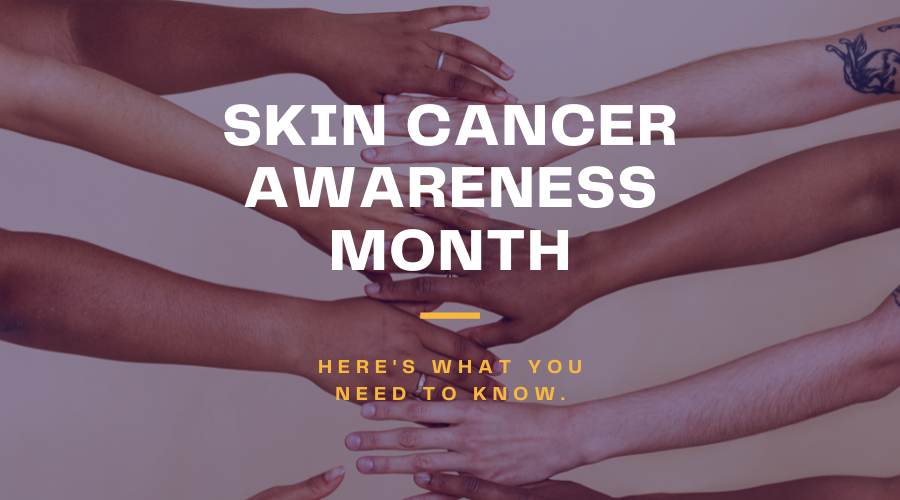Did you know that one out of five Americans will develop skin cancer by age 70?
May is skin cancer awareness month and we at ShearShare want to make sure that our community is not only aware of what causes skin cancer but also what preventive measures you can take to avoid it happening to you or a loved one. Skin cancer is the most common type of cancer in the United States, according to The Skin Cancer Foundation (SCF). But with a comprehensive understanding of causes and preventive measures, you can greatly decrease the chances of it affecting you.
What is Skin Cancer?
Skin cancer is the out-of-control growth of abnormal cells in the epidermis which is the outermost skin layer, caused by unrepaired DNA damage that triggers mutations. These mutations lead the skin cells to multiply rapidly and form malignant tumors. A myriad of things can cause cancer. But the two main causes are the sun’s harmful ultraviolet (UV) rays and the use of (UV) tanning beds. The good news is that if it’s caught early and treated, you’ll have better odds of eliminating it.
Types of Skin Cancer & Causes:
Basal cell carcinoma
- What is it? – Basal cell carcinomas (BCCs) are abnormal, uncontrolled growths that arise from the skin’s basal cells in the outermost layer of skin (epidermis).
- What causes it? – Most BCCs are caused by the combination of intermittent, intense exposure and cumulative, long-term exposure to UV radiation from the sun.
Squamous cell carcinoma
- What is it? – Squamous cell carcinoma (SCC) is an uncontrolled growth of abnormal cells arising from the squamous cells in the outermost layer of skin (epidermis).
- What causes it? – Cumulative, long-term exposure to UV radiation from the sun and tanning beds causes most SCCs.
Melanoma
- What is it? – Melanoma is cancer that develops from melanocytes, the skin cells that produce melanin pigment, which gives skin its color.
- What causes it? – Melanoma is often triggered by the kind of intense, intermittent sun exposure that leads to sunburn. Tanning bed use also increases the risk for melanoma.
Merkel cell carcinoma
- What is it? – Merkel cell carcinoma (MCC) is a rare, aggressive skin cancer.
- What causes it? – Usually associated with a virus called the Merkel cell polyomavirus, MCCs most often arise on sun-exposed areas in fair-skinned individuals over age 50.
“The good news is that if it’s caught early and treated, you’ll have better odds of eliminating it.”
Skin Cancer Identification Tips
Skin cancer is cancer you can see because they form on the outside and are usually visible. That’s why skin exams, both at home and with a dermatologist, are especially vital. Learning what to look for on your skin gives you the power to detect cancer early when it’s easiest to cure before it becomes dangerous, disfiguring, or even deadly. Examine your skin once a month. If you spot anything that doesn’t look right, be sure to document your findings and share them with a dermatologist.
What to look for:
- A growth that increases in size and appears pearly, transparent, tan, brown, black, or multicolored.
- A mole, birthmark, or brown spot that increases in size, thickness, changes color or texture or is bigger than a pencil eraser.
- A spot or sore that continues to itch, hurt, crust, scab or bleed.
- An open sore that does not heal within three weeks.
As part of a complete early detection strategy, SCF recommends that you see a dermatologist once a year, or more often if you are at a higher risk of skin cancer, for a full-body, professional skin exam.
Skin Cancer Prevention Tips
Though the sun can be beneficial, its UV radiation can be detrimental to our health. It’s not just beach days that you have to be careful of. Sun damage can accumulate over the years from prolonged outdoor exposure such as walking your dog, exercising outside, or walking back and forth to your car. Below are recommendations from SCF to prevent skin cancer from happening to you.
- Seek the shade, especially between 10 am and 4 pm
- Don’t get sunburned.
- Avoid tanning, and never use UV tanning beds.
- Cover up with clothing, including a broad-brimmed hat and UV-blocking sunglasses.
- Use a broad-spectrum (UVA/UVB) sunscreen with an SPF of 15 or higher every day. For extended outdoor activity, use a water-resistant, broad-spectrum (UVA/UVB) sunscreen with an SPF of 30 or higher.
- Apply 1 ounce (2 tablespoons) of sunscreen to your entire body 30 minutes before going outside. Reapply every two hours or after swimming or excessive sweating.
- Keep newborns out of the sun. Use sunscreen on babies over the age of six months.
- Examine your skin head-to-toe every month.
- See a dermatologist at least once a year for a professional skin exam.
No single method of sun defense can protect you perfectly. The best path to beautiful, healthy skin is to adopt as many of these steps as possible into your lifestyle, and make them daily habits everywhere you go, all year long. For more information, check out SCF’s skin cancer prevention PDF. And remember, early detection starts with YOU.
Join ShearShare!
Download the free ShearShare app to reimagine how, when, and where you work. Also, check out our blog for resources, updates, and news that will undoubtedly take your career to the next level. And be sure to follow ShearShare on all social media platforms to capture the behind-the-scenes fun of building a tech company for us, by us!
Did you learn something new? Do you have a question? Leave a comment and join the conversation with other #ShearShareCommunity members!

